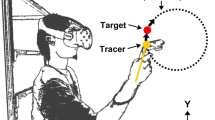Abstract
Goal-directed reaching movements in three-dimensions are important for our interaction with the environment. Instrumented setups displaying virtual targets for rehabilitation training of reaching movements often provide limited depth cues, which may affect movements. This work aims to quantify effects of limited depth cues on reaching movements. We developed a virtual environment for assessing three-dimensional reaching movements that allows different depth cues to be enabled or disabled. By imposing a fixed spatial tolerance around targets for speed-accuracy trade-off, completion time normalized with the straight-line distance to the target was used to measure reaching performance. In the present study, 8 (control) subjects using a typical monitor setup applied in rehabilitation were compared to 7 subjects using a head-mounted display and receiving additional depth cues, namely, hard-referenced objects of known size, motion parallax due to tracked head-movements, and stereopsis. Control subjects required on average 9.88 s/m straight-line distance, while subjects using the head-mounted display required only 3.15 s/m straight-line distance. Additionally, movement trajectories of control subjects showed a different pattern, indicating a lack of reliable depth information. Thus, state-of-the-art rehabilitation setups are challenging already for healthy subjects. This challenge can be reduced by improving the provided visual depth cues.
Access this chapter
Tax calculation will be finalised at checkout
Purchases are for personal use only
Similar content being viewed by others
Notes
- 1.
High Tech Computer Corporation (HTC), Taoyuan, Taiwan.
- 2.
Oculus VR LLC, Menlo Park, California, USA.
- 3.
Sony Corporation, Minato, Tokyo, Japan.
- 4.
Microsoft Corporation, Redmond, Washington State, USA.
- 5.
Intel Corporation, Santa Clara, California, USA.
- 6.
Nvidia Corporation, Santa Clara, California, USA.
- 7.
Valve Corporation, Bellevue, Washington State, USA.
- 8.
Unity Technologies, San Francisco, California, USA.
References
Arsenault, R., Ware, C.: The importance of stereo and eye-coupled perspective for eye-hand coordination in fish tank VR. Presence: Teleoperators Virtual Environ. 13(5), 549–559 (2004)
Birkenmeier, R.L., et al.: Translating animal doses of task-specific training to people with chronic stroke in 1-hour therapy sessions: a proof-of-concept study. Neurorehabilitation Neural Repair 24(7), 620–635 (2010)
Keller, U., et al.: Robot-assisted arm assessments in spinal cord injured patients: a consideration of concept study. PloS one. 10(5), e0126948 (2015)
Klamroth-Marganska, V., et al.: Three-dimensional, task-specific robot therapy of the arm after stroke: a multicentre, parallel-group randomised trial. Lancet Neurol. 13(2), 159–166 (2014)
Meyer-Heim, A., van Hedel, H.J.: Robot-assisted and computer-enhanced therapies for children with cerebral palsy: current state and clinical implementation. Semin. Pediatr. Neurol. 2013, 139–145 (2013)
Mihelj, M., et al.: Virtual rehabilitation environment using principles of intrinsic motivation and game design. Presence: Teleoperators Virtual Environ. 21(1), 1–15 (2012)
Oldfield, R.C.: The assessment and analysis of handedness: the Edinburgh inventory. Neuropsychologia 9, 97–113 (1971)
Riener, R., Harders, M.: Virtual Reality in Medicine. Springer, London (2012)
Unity Technologies OpenVR. https://docs.unity3d.com/manual/vrdevices-openvr.html. Accessed 13 Apr 2017
Valve Corporation SteamVR-Tracking. https://partner.steamgames.com/vrtracking/. Accessed 13 Apr 2017
Wittmann, F., et al.: Self-directed arm therapy at home after stroke with a sensor-based virtual reality training system. J. Neuroeng. Rehabil. 13(1), 75 (2016)
Author information
Authors and Affiliations
Corresponding author
Editor information
Editors and Affiliations
Rights and permissions
Copyright information
© 2018 Springer International Publishing AG
About this paper
Cite this paper
Gerig, N., Mayo, J., Baur, K., Wittmann, F., Riener, R., Wolf, P. (2018). Missing Depth Cues in Virtual Reality Decrease Performance of Three-Dimensional Reaching Movements. In: Lames, M., Saupe, D., Wiemeyer, J. (eds) Proceedings of the 11th International Symposium on Computer Science in Sport (IACSS 2017). IACSS 2017. Advances in Intelligent Systems and Computing, vol 663. Springer, Cham. https://doi.org/10.1007/978-3-319-67846-7_12
Download citation
DOI: https://doi.org/10.1007/978-3-319-67846-7_12
Published:
Publisher Name: Springer, Cham
Print ISBN: 978-3-319-67845-0
Online ISBN: 978-3-319-67846-7
eBook Packages: EngineeringEngineering (R0)




